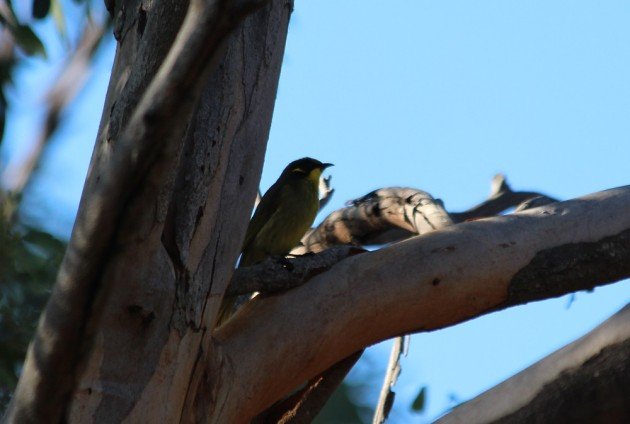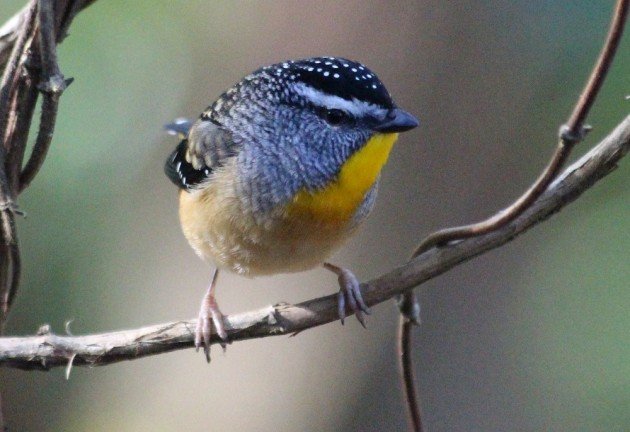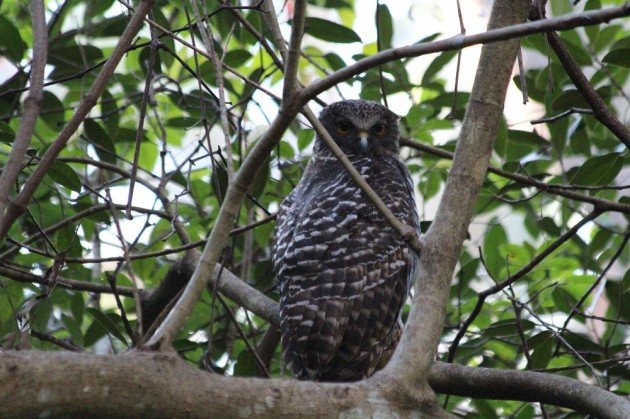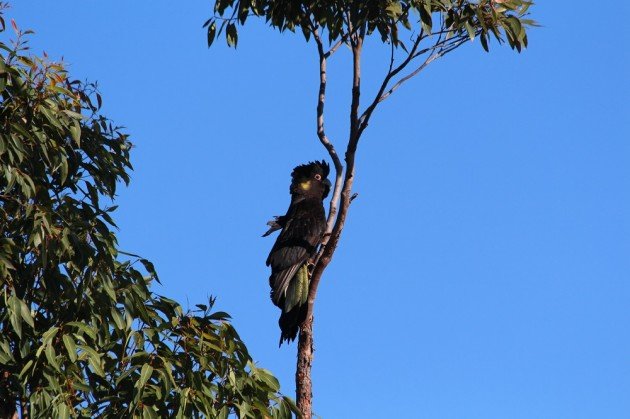
Laid out as I was with some nasty virus for most of my trip to Sydney, a lot of the excursions I planned for that week kind of fell by the wayside. I wouldn’t even say the spirit was willing but the flesh was weak, because the spirit had been pretty badly drained by the whole thing too. But there was one trip I wasn’t going to miss, a midweek excursion by the Cumberland Bird Observers Club, the people to go out with in Sydney if you want birds. You might recall the fun trip I had with them last year in Sydney’s western parks. The trip was to visit a handful of sites across North Sydney, which was great for me as they were places I could stand to know better and were close to where my family live (and I was staying).
Getting to the start off point, the Ingleside Track on the southern end of Ku-Ring-Gai Chase NP, was surprisingly difficult. Even going against (you’d think) the traffic rush hour snarled me up, but I got there, to be greeted by a mass flyover of Yellow-tailed Black Cockatoos. These are enormous parrots, and very striking in their black plumage. At least there wasn’t any confusion about where I was supposed to be, as these cockatoos were being watched by a lot of people. Another nice find by the assembled birders was a Bar-shouldered Dove, a species I had only seen in Queensland before this point.
Yellow-tailed Black Cockatoo
We set off down the trail, the target, insofar as it wasn’t just whatever we could see, was Regent Honeyeaters, a rare winter migrant that had been seen along the trail a few weeks back. Alas, this wasn’t to be our time for that rarity, but the trail certainly delivered honeyeaters. First off was a typical honeyeater for the park, an Eastern Spinebill. I usually have to come up to Ku-Ring-Gai to get this heathland species, but I had actually seen one a few days earlier in the little patch of heath near my grandmother’s house, which was a rather startling first. Next was White-naped Honeyeaters, a compact pretty little bird with a white front, black head and olive back. I’ve seen the species here and there over the years, but today they were utterly ubiquitous, even our guide had never seen this many. There were also the noisy Little Wattlebirds, the heathland White-cheeked Honeyeater and an overflight by the odd Noisy Friarbirds, a large and mostly naked-headed honeyeater that again I had recently seen on my patch for the first time. Best of all was a pretty Yellow-tufted Honeyeater, my first lifer of the day.
 A bad photo of a Yellow-tufted Honeyeater
A bad photo of a Yellow-tufted Honeyeater
There were other birds as well, including the tiny and adorable Variagated Fairy-wrens, a Spotted Pardalote that was nesting in a burrow in a bank by the path, a Golden Whistler and many of the commoner species like Australian Raven and Pied Currawongs. A passing raptor was, depending on who you asked, certainly or probably a Brown Goshawk. After we got back to the cars everyone pulled chairs out and sat down for a cup of tea (I had neglected to bring some but was not to go without thanks to the hospitality of these fine people). I talked to an American visitor from Hawaii who had brought his wildlife-mad son along. They had been in Aussie for a few days to do some skiing, and while his wife and daughter were out with the shops they were out with us. The kid was about seven but utterly enthusiastic and capable of reciting great swathes of facts about animals and where he had seen this bird or animal – it reminded me a little of myself at that age!
 Spotted Pardalotes are uniquely Australian birds
Spotted Pardalotes are uniquely Australian birds
After a refreshing tea we made for a spot down the coast in the suburb of Narabeen, a place called Deep Creek, where a rarity that was being much discussed over the tea had been showing up lately. I found the idea that I’d see it pretty laughable, but I went along with the group since I figured we’d see something, but sometimes even us cynics are wrong, and sure enough, where promised, there was a Noisy Pitta. A pitta, in Sydney, in winter, is a pretty mega bird. And Deep Creek was hardly the wildest spot in the world. It was foraging under some trees on the edge of a huge area of mown grass where people were walking their dogs. Compared to some stories of day long treks in mosquito filled jungles to see some species, it’s amazing to see a pitta with no more effort than crossing a football pitch.
Deep Creek didn’t have a whole lot else, but across the road we were able to scout out Narabeen Lagoon, were we spied Ospreys, White-bellied Sea-eagles and Australian Pelicans. By this point my virus was catching up with me and I was completely and utterly exhausted, but then a new prize was dangled in front of me, if I could hang on just a few more minutes. It turned out that there was another pitta knocking about in nearby Warriewood Swamp, and people looking for that bird had made another equally exciting find. It was too good an opportunity to pass up, so I got in my car for the drive to Warriewood.
Warriewood is a site I visited last year and hit honeyeater and lorikeet heaven. I must have been very lucky with my timing because I was there when swamp mahoganies were flowering and this brings the nectar hunters in droves. It wasn’t nearly as busy this time, but still okay for wetland birds. Not that we lingered to look, we were on a mission. We did find a Australian Brush Turkey on the way (another bird that is making rapid progress invading Sydney), which was a nice find for the American family, but we pressed on through the swamp’s elevated walkways until we reached a small opening, where, as promised (miraculously!) was a Powerful Owl. Australia’s largest owl species, and, actually, the first owl I have ever seen there, it shows up here and there in Sydney, but finding one usually depends on knowing someone who knows where one is hanging out. Even had I known there was one in the area I would never have found it. So thank you, the fine people of the Cumberland Bird Observers Club, for putting up with me two years in a row and showing me so many fine birds. And if you ever visit Sydney, look them up, they are outstandingly generous hosts and you will have a great time.
 A Powerful Owl is a very strong contender for my bird of the year.
A Powerful Owl is a very strong contender for my bird of the year.














Leave a Comment